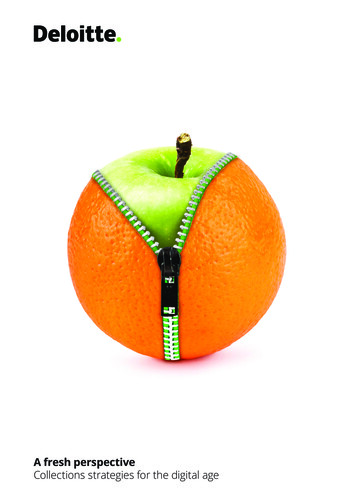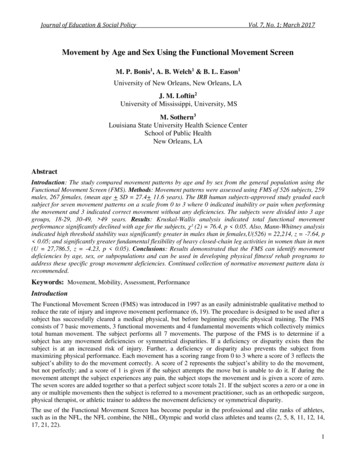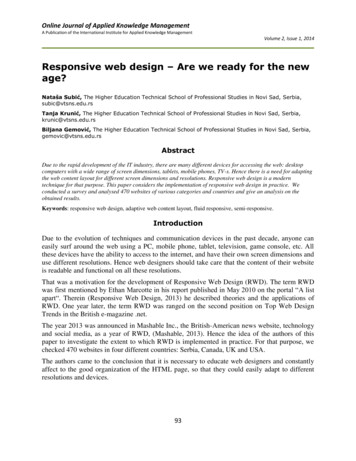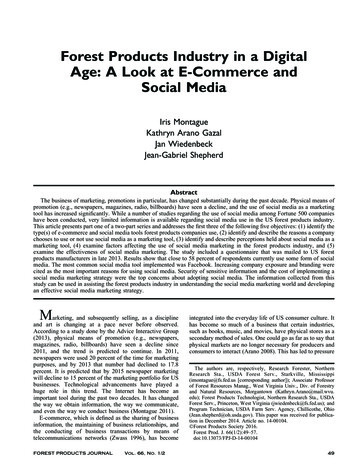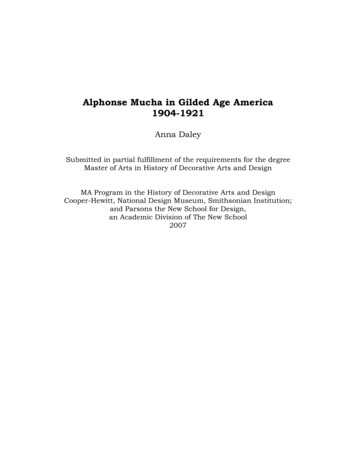
Transcription
Alphonse Mucha in Gilded Age America1904-1921Anna DaleySubmitted in partial fulfillment of the requirements for the degreeMaster of Arts in History of Decorative Arts and DesignMA Program in the History of Decorative Arts and DesignCooper-Hewitt, National Design Museum, Smithsonian Institution;and Parsons the New School for Design,an Academic Division of The New School2007
2007Anna DaleyAll Rights Reserved
iTable of Contents1. List of Illustrations .ii-iii2. Introduction 1-33. Early Career and the Lure of America 3-94. First Trip: March 6—May 19, 1904, New York .9-235. Second Trip: January—Late July/Early August 1905, NewYork .23-276. Third Trip: November 22, 1905—May 1906, New York .27-417. Fourth Trip: October 1906—November 1909, Chicago and NewYork .41-628. Fifth Trip: Late November 1909—March 17, 1910, Lake Forest andChicago .62-659. Sixth Trip: February—Late March/April 1913, Chicago and NewYork .65-7110. Seventh Trip: Late 1919/Early 1920—March 1921, New York andChicago .71-7711. Mucha’s Final Years: 1928-1939 . .77-7812. Conclusion .78-7913. Bibliography .80-8314. Illustrations .84-105
iiList of IllustrationsFigure 1: Design for leaflet for first Cours Mucha, 1897Figure 2: Gismonda, 1894Figure 3: Job, 1896Figure 4: Carriage Dealers Philadelphia Exposition, 1902Figure 5: Friendship from the New York Daily News, April 3, 1904Figure 6: Designs from Figures Décoratives, 1905Figure 7: Reproduction of the front and back covers of the ArtSupplement of the New York Daily News, April 3, 1904Figure 8: New York Daily News poster, 1904Figure 9: “A Chat with M. Mucha: Opinions and Workof a Parisian Artist,” New York Sun, April 10, 1904.Figure 10: Nymph and Butterfly Lamp Pendant by Louis Comfort Tiffanyfrom a design by Alphonse Mucha, ndFigure 11: Portrait of Mrs. Wismann, 1904Figure 12: Portrait of John Cardinal Farley, 1908Figure 13: Isabella Stewart Gardner, John Singer Sargent, 1888Figure 14: Savon Mucha point of purchase display, 1906Figure 15: Les Fleurs, 1898Figure16: Portrait of Milada Cerny, from the Chicago Tribune, June 28,1905Figure 17: Poster for St. Vincent’s Orphans Pound Party, from the ChicagoTribune, December 9, 1906Figure18: Lefevre-Utile advertisement, 1903Figure 19: Jell-O advertisement, 1910Figure 20: Cream of Wheat advertisement, 1906Figure 21: Slavia, advertisement for Mutual Bank of Prague, 1907Figure 22: Photo of Alphonse in front of Portrait of Mrs. Robert William
iiiLeatherbee and her son Charles, ndFigure 23: The Birth of Beauty for the German Theatre, 1908Figure 24: Comedy for the German Theatre, 1908Figure 25: Tragedy for the German Theatre, 1908Figure 26: Panel from the Seven Beautitudes representing “Blessed arethe poor in spirit: for theirs is the kingdom of heaven,” fromEverybody’s Magazine, December 1906Figure 27:Leslie Carter, 1909Figure 28: Maude Adams, 1909Figure 29: Zdenka Černy, 1913Figure 30: Rudolf Firml, 1906Figure 31: The Abolition of Serfdom in Russia, 1919Figure 32: Mucha Exhibition, Brooklyn Museum, 1920Figure 33: Covers of Hearst’s International Magazine, May and December1922
1IntroductionCzech graphic designer and painter Alphonse Maria Mucha periodicallyvisited America between 1904 and 1921. While in America, Mucha producednumerous and varied works of art and design products. Some of the works hecreated while in America, lithography for magazine covers, concert posters, andadvertisements, were similar in composition to his most famous lithographsproduced in his most fertile period, the Paris years, 1894-1904. However,much of the work Mucha produced in America was unique in his oeuvre andfurthermore, in type or media, is rarely associated with a man typicallycategorized as a graphic or decorative designer. These atypical works includeoil portraits and massive panneau painted in an increasingly naturalistic andacademic style, the interior design of the German Theatre, and set and costumedesigns. Perhaps his most distinctly American works, if not in compositionthan in the social milieu that generated them, are his package designs for hisown line of soap, Savon Mucha.In addition, during his tenure in America, Mucha finally realized hisambition to teach his own course, mixed and mingled with some of the GildedAge’s most recognizable names, and became a celebrity. Mucha taught his“Cours Mucha” on the fundamentals of drawing and the history of American Artin New York at the New York Women’s School of Applied Design (also known asthe School of Applied Design for Women) and in Chicago at the Art Institute. InNew York, Mucha quickly endeared himself to Mr. and Mrs. CorneliusVanderbilt, the George J. Goulds, Charles R. Crane and Charles Schwab. InChicago, Mucha became friends with Mrs. Potter Palmer and Mrs. MarshallField. Mucha also claimed acquaintance with a President of the United States,Theodore Roosevelt. Newspapers in New York, Boston, Philadelphia, and
2Chicago frequently featured stories about all of the aforementioned projects andthe social gatherings he attended. In addition, newspapers and magazinesoften reproduced examples of Mucha’s earlier work during this period.By 1904 the Aesthetic movement was a thing of the past and ArtNouveau was fast loosing its currency. Moreover, some scholars believe that by1904 Mucha’s most productive years and best work were behind him. Yet,Mucha seemed to be omnipresent in American visual culture and a powerfultastemaker at this time. In the following pages, I will attempt to explain whyMucha’s work continued to be popular in America through the 1920s althoughhis two most prevalent styles of working in this period, Art Nouveau andacademic history painting, and the aesthetic theory that informed them, wererapidly being eclipsed by Modernism. By understanding why Mucha, his work,and his lectures were as wildly popular, as his biographies claim, a new lightcan be shed on Gilded Age taste and the American art community at the turn ofthe century.The years Mucha spent in America constitute a little-known chapter ofhis career. Mucha holds an important place in the history of art and designand although he produced some of the most instantly recognizable Art Nouveaugraphic art, little scholarly work has been done on his career and none hasbeen done specifically on his time in America. Mucha’s son, Jiří, is Mucha’ssole biographer and his two attempts, cited in my bibliography, are far fromscholarly. The scholarly work that has been done on Mucha focuses primarilyon his work in Paris in the 1890s and his painting cycle, The Slav Epic. Jiří hasdrawn the timeline of his father’s life almost exclusively from his father’s lettersto his mother, Maruška (Maria Chytilová). No corroborative research has been
3done to substantiate or elaborate upon any of his father’s assertions or claimsabout his work or social life. Jiří provides his father’s voice and the history ofhis years in America and I will provide the framework of popular culture, highsociety, and the artistic world of turn-of-the-century America within which toplace this narrative. Larger social and cultural issues such as the triumph of“personality” in the twentieth century, the emergence of the “New Woman” andthe growing importance of media attention, in addition to wealthy patronage,informed Mucha’s American experience. By combining Mucha’s personal historyand these factors with stylistic and formal analyses of the works produced inthis period, I can illuminate an otherwise forgotten chapter of his career.Prologue: Early Career and the Lure of AmericaAlphonse Maria Mucha was born on July 24, 1860 in Ivančice, a smallMoravian town in what was then the Kingdom of Bohemia and is now the CzechRepublic. As a child Mucha showed an early aptitude for drawing. Accordingto Mucha family lore his mother tied a pencil around his neck so that he coulddraw as he crawled around the family home. He received his first watercolor seton his third Christmas and took to painting immediately.As an adult, Mucha’s first employment as a painter was with a Viennatheatrical scenery and curtain company, Kautsky-Brioschi-Burghardt, in theautumn of 1879 or the spring of 1880. He worked for the next five years as apainter in various capacities throughout the Austro-Hungarian Empire. In1885, Mucha finally began his formal training as an artist at the Akademie inMunich. After completing two years of study Mucha left the Akademie and,with the help of his long-time patron Count Carl Kuhen, established himself inParis, first at the Académie Julian and later at the Académie Colarossi. After
4leaving the Colarossi, he supported himself by producing illustrations formagazines and newspapers; it was hard but steady work.1Mucha’s career as an illustrator for publications slowly produced moreand more important commissions and by 1894 he had attracted a group ofpupils who would come to have their drawings corrected. In 1897, as thenumber of his pupils grew, Mucha began his first regular course in compositionand decorative drawing (figure 1). In 1898 Mucha joined his pupils with those ofAmerican ex-patriot painter James Abbott McNeill Whistler. The partnershipended in 1901, but the two artists parted as friends. According to Jiří, yearslater when a student asked Whistler why he had so many of Mucha’s postershanging in his rooms, Whistler retorted, “So that I can show fools like you whatit means to be able to draw.”2Mucha’s most famous collaboration, with the actress Sarah Bernhardt,began in haste. In late 1894 Mucha was working for the printing firmLemercier on a commission for the Brazilian government. The day afterChristmas, Bernhardt phoned the manager of Lemercier, Maurice Brunoff, andasked him to produce a new poster for her production of Gismonda by NewYear’s Day. Brunoff, frantic and short-handed, gave the assignment to the stilllittle-known Bohemian illustrator. The poster’s long, narrow dimensions andsubtle colors worried Brunhoff but vastly impressed Bernhardt (figure 2).Mucha’s Gismonda caused a sensation and over the next six years he designedalmost all of Bernhardt’s production posters including Les Amants (1895), La1Jiří Mucha, The Master of Art Nouveau: Alphonse Mucha, GeraldineThompson, trans (Prague: Knihtsk, 1966), 13, 16, 24-33, 35, 44, 46. Hereafter TMAN:AM.2TMAN:AM, 63-64.
5Dame Aux Camélias (1896), Lorenzaccio (1896), La Samaritaine (1897), Médée(1898), Hamlet (1899), La Tosca (1899), and L’Aiglon (1900).3Mucha achieved such a high level of fame in Paris through hisassociation with Bernhardt that commissions soon flooded in. The decadebeginning in 1894 encompassed the years of Mucha’s greatest output andgreatest renown. In the late 1890s, publishers paid Mucha upwards of 500francs for a cover illustration and reproductions of his advertising posters, suchas the iconic Job of 1896, sold for as many as twenty-five francs. The cost of agood lunch during this period, Jiří notes, was only two or three francs (figure3).4 After a successful showing of his work at the Exposition universelleinternationale de 1900, many firms produced objects featuring Mucha’sdesigns, such as carpets, fabrics, and furniture. Celebrated jeweler GeorgesFouquet won many awards for the pieces he produced from Mucha’s drawings.The most famous of these Fouquet-produced pieces is the snake armbandMucha designed for Sarah Bernhardt, which he included in the poster forMédée.5Mucha signed an exclusive contract with the printer Champenois in late1895 or early 1896 in order to secure himself a regular monthly salary. It wasthanks to the industry of Champenois that not only did Mucha’s fame continueto grow in Paris, but also that he became known in America. Champenoislicensed Mucha’s designs and illustrations to companies and publications3Ibid, 67, 75, 78.Ibid, 89 and; Jiří Mucha, Alphonse Maria Mucha: His Life and Art (New York: Rozzoli, 1989), 222.Hereafter AMM:HLA.4Anna M. Dvořák, “Alphonse Mucha: Book Illustrations and Mural Paintings” (PhD diss.,University of North Carolina, 1978), 51.5
6throughout Europe and America, often with alterations. Mucha designs, invarious incarnations, could be found on calendars, postcards, andadvertisements for such varied products as Fox-Land Jamaican Rum and TheCarriage Dealers Journal, published in Philadelphia (figure 4).6The contract with Champenois did indeed provide some financialsecurity, but it also resulted in an overload of work. Mucha dramaticallyexplained his situation in a letter from January 1904, “You’ve no idea how oftenI am crushed almost to blood by the cogwheels of this life, by this torrent whichhas got hold of me, robbing me of my time and forcing me to do things that areso alien to those I dream about.”7 It was this daily pressure to churn out workfor mass distribution that would motivate Mucha to leave Paris in 1904.8The constant output necessary to fulfill his contract with Champenoiskept him from embarking on what he envisioned would be his magnum opus, amural cycle dedicated to the history of his people, the Slavs. Mucha believed heneeded to accumulate more money more quickly in order to be able to singlemindedly dedicate himself to his epic. America appeared to offer the solution.Mucha reasoned in an undated letter to his then fiancé, Maruška, “From myexperience of Americans in Paris, from the interest in my work in America andknowing I had friends I could rely on, I came to the conclusion that I would dobetter if I tried America, where the circulation of money was more lively.”9Jack Rennert and Alain Weill, Alphonse Mucha: The Complete Posters and Panels,(Boston: A Hjert and Hjert
Everybody’s Magazine, December 1906 Figure 27:Leslie Carter, 1909 . Czech graphic designer and painter Alphonse Maria Mucha periodically visited America between 1904 and 1921. While in America, Mucha produced numerous and varied works of art and design products. Some of the works he created while in America, lithography for magazine covers, concert posters, and advertisements,




